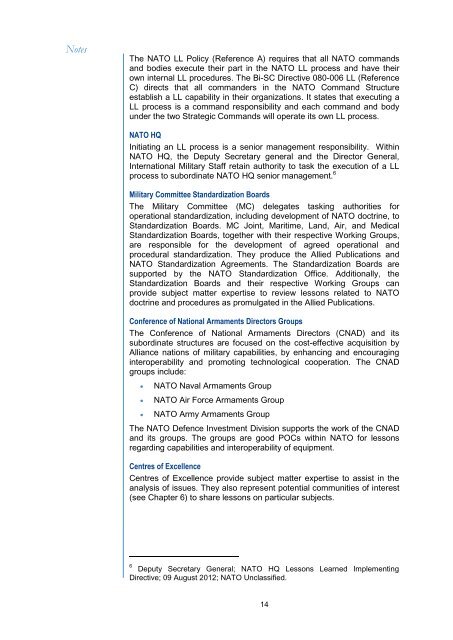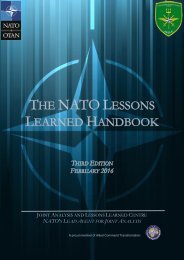JOINT ANALYSIS LESSONS LEARNED CENTRE NATO'S LEAD AGENT JOINT ANALYSIS
1ViofYb
1ViofYb
Create successful ePaper yourself
Turn your PDF publications into a flip-book with our unique Google optimized e-Paper software.
Notes<br />
The NATO LL Policy (Reference A) requires that all NATO commands<br />
and bodies execute their part in the NATO LL process and have their<br />
own internal LL procedures. The Bi-SC Directive 080-006 LL (Reference<br />
C) directs that all commanders in the NATO Command Structure<br />
establish a LL capability in their organizations. It states that executing a<br />
LL process is a command responsibility and each command and body<br />
under the two Strategic Commands will operate its own LL process.<br />
NATO HQ<br />
Initiating an LL process is a senior management responsibility. Within<br />
NATO HQ, the Deputy Secretary general and the Director General,<br />
International Military Staff retain authority to task the execution of a LL<br />
process to subordinate NATO HQ senior management. 6<br />
Military Committee Standardization Boards<br />
The Military Committee (MC) delegates tasking authorities for<br />
operational standardization, including development of NATO doctrine, to<br />
Standardization Boards. MC Joint, Maritime, Land, Air, and Medical<br />
Standardization Boards, together with their respective Working Groups,<br />
are responsible for the development of agreed operational and<br />
procedural standardization. They produce the Allied Publications and<br />
NATO Standardization Agreements. The Standardization Boards are<br />
supported by the NATO Standardization Office. Additionally, the<br />
Standardization Boards and their respective Working Groups can<br />
provide subject matter expertise to review lessons related to NATO<br />
doctrine and procedures as promulgated in the Allied Publications.<br />
Conference of National Armaments Directors Groups<br />
The Conference of National Armaments Directors (CNAD) and its<br />
subordinate structures are focused on the cost-effective acquisition by<br />
Alliance nations of military capabilities, by enhancing and encouraging<br />
interoperability and promoting technological cooperation. The CNAD<br />
groups include:<br />
<br />
<br />
<br />
NATO Naval Armaments Group<br />
NATO Air Force Armaments Group<br />
NATO Army Armaments Group<br />
The NATO Defence Investment Division supports the work of the CNAD<br />
and its groups. The groups are good POCs within NATO for lessons<br />
regarding capabilities and interoperability of equipment.<br />
Centres of Excellence<br />
Centres of Excellence provide subject matter expertise to assist in the<br />
analysis of issues. They also represent potential communities of interest<br />
(see Chapter 6) to share lessons on particular subjects.<br />
6<br />
Deputy Secretary General; NATO HQ Lessons Learned Implementing<br />
Directive; 09 August 2012; NATO Unclassified.<br />
14



